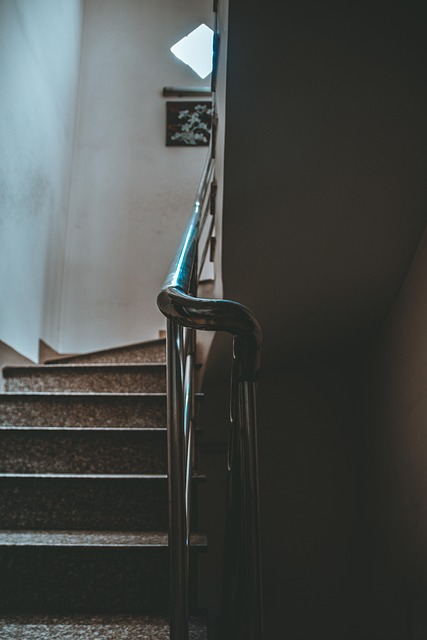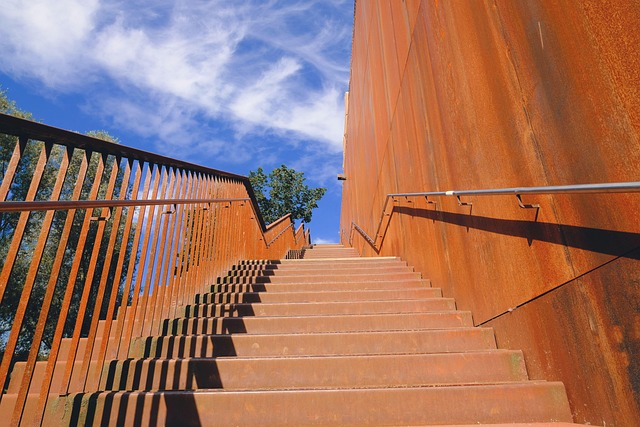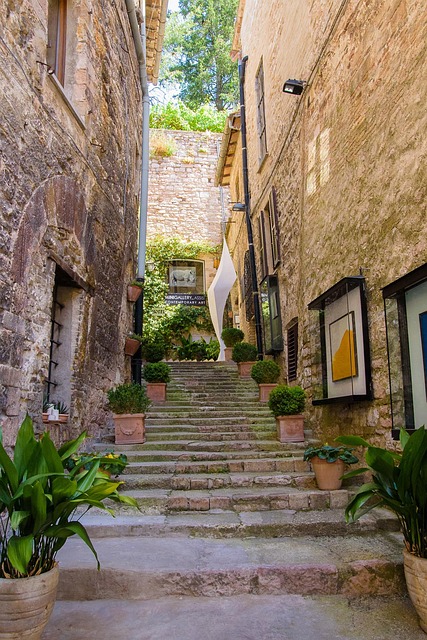Modern Minimalist Metal Handrails: Clean Lines for Contemporary Spaces

Minimalist design trends have elevated decorative metal handrails from functional safety features to…….
Metal Handrails for Stairs: A Comprehensive Guide
Introduction
Staircases are a fundamental element of architecture, providing access between different levels within a structure. Safety and functionality are paramount when designing staircases, and one critical component that enhances both is the metal handrail. This article delves into the world of metal handrails for stairs, exploring their significance, global impact, economic considerations, technological advancements, policy landscape, challenges, case studies, and future prospects. Readers will gain a comprehensive understanding of how these fixtures are not just a design element but a vital safety feature that influences various facets of construction, economics, and safety standards worldwide.
Understanding Metal Handrails for Stairs
Metal handrails are vertical bars or supports designed to be grasped by the hand for stability and support when ascending or descending stairs. They are an integral part of a staircase’s design, serving both aesthetic and functional purposes. Comprising various materials like stainless steel, aluminum, brass, and wrought iron, these handrails offer both durability and style. Their historical context dates back to ancient civilizations, where simple rails were introduced for nobility and later became more widespread due to technological advancements and safety concerns. Today, metal handrails are a standard feature in residential, commercial, and public buildings, ensuring safety and accessibility for all users.
Global Impact and Trends
The influence of metal handrails for stairs is evident across the globe, with each region adapting designs to suit local tastes and building codes. Europe, North America, and parts of Asia lead in innovative designs and stringent safety standards. The global trend towards sustainable and eco-friendly materials has also impacted the metal handrail industry, with an emphasis on recyclable metals and energy-efficient manufacturing processes. Furthermore, the rise in multi-story residential and commercial buildings has fueled demand for these fixtures, making them a vital component of modern architecture.
Economic Considerations
The economic aspects of metal handrails for stairs are multifaceted. They represent a niche market within the construction industry, with market dynamics influenced by factors such as material costs, labor availability, and regional demand. Investment patterns in real estate and infrastructure development directly affect the demand for these fixtures. In developed economies, the focus is on retrofitting existing buildings to comply with updated safety regulations, while emerging markets are witnessing a surge in new constructions incorporating metal handrails from the outset. These economic considerations underscore the importance of metal handrails as both a cost and a critical investment in public safety.
Technological Advancements
Technological advancements have significantly impacted the design and functionality of metal handrails for stairs. Innovations such as smart railings that provide haptic feedback for visually impaired individuals, anti-microbial coatings to reduce germ transmission, and self-healing materials are revolutionizing the industry. The use of computer-aided design (CAD) and 3D printing has allowed for more intricate and customizable designs, while advances in material science have led to stronger, lighter, and more sustainable options. These technological strides are set to continue, offering even greater safety, efficiency, and aesthetics in metal handrails for stairs.
Policy and Regulation
The policies and regulations governing metal handrails for stairs are comprehensive and vary by jurisdiction. International standards like those from the International Organization for Standardization (ISO) provide guidelines on design, material, and installation. Building codes and safety regulations at the national and local levels mandate the use of handrails in public and commercial spaces. These legislative frameworks ensure that metal handrails meet specific criteria for load-bearing capacity, user safety, and accessibility, thereby influencing their development and integration into building designs.
Challenges and Criticisms
Despite their importance, metal handrails for stairs face several challenges and criticisms. Issues such as compliance with varying regulations, durability concerns, and the balance between design aesthetics and safety are ongoing debates. The cost of materials and installation can be prohibitive in some regions, especially where economic constraints limit investment in infrastructure. Additionally, there are environmental considerations regarding the manufacturing and disposal of handrail materials. Addressing these challenges requires a collaborative effort among designers, manufacturers, policymakers, and end-users to ensure that metal handrails for stairs are both functional and sustainable.
Case Studies
Several case studies exemplify the successful application of metal handrails for stairs. The Burj Khalifa in Dubai, with its towering staircases, features handrails designed to withstand extreme conditions, showcasing innovation in design and material choice. The Grand Central Terminal in New York has undergone restoration efforts that included the refurbishment of its iconic metal handrails, highlighting the importance of maintaining these fixtures. These case studies provide valuable insights into best practices and the long-term impact of well-designed and implemented metal handrail systems.
Future Prospects
Looking ahead, the future prospects for metal handrails for stairs are promising. The growing emphasis on accessibility, safety, and sustainable design will drive innovation and adoption in this sector. Smart materials that adapt to different environmental conditions and energy-efficient manufacturing processes will likely become standard. Additionally, the integration of technology, such as sensors and interactive displays, could transform metal handrails into multifunctional components within our built environment. The potential for these fixtures to evolve and contribute to the safety, aesthetics, and functionality of stairs is boundless.
Conclusion
Metal handrails for stairs are more than just functional elements; they are a testament to the integration of safety, design, and technology in our built environment. From historical designs to modern innovations, their evolution reflects broader societal shifts and technological advancements. As the global demand for these fixtures grows, so too does the potential for sustainable, safe, and aesthetically pleasing solutions. The future of metal handrails for stairs is one of continuous adaptation and progress, ensuring that they remain an essential component of architecture worldwide.
This article provides a comprehensive overview of metal handrails for stairs, from their historical context to the cutting-edge technologies shaping their future. It highlights the importance of these fixtures in terms of safety, design, and sustainability, and it underscores the need for ongoing innovation to meet evolving standards and expectations. As the industry moves forward, it is clear that metal handrails will continue to play a critical role in our built environment, ensuring accessibility, safety, and beauty for generations to come.

Minimalist design trends have elevated decorative metal handrails from functional safety features to…….

Understanding ADA compliance is vital when designing or installing decorative metal handrails, as it…….

Custom metal stair handrails with textured surfaces are essential for enhancing safety on stairs in…….

Decorative metal handrails, crafted from materials like stainless steel, wrought iron, aluminum, and…….

Durable stair handrails with textured anti-slip surfaces are crucial for enhancing safety in public…….

Regular maintenance is crucial for preserving the longevity and aesthetic appeal of stainless steel…….

Powder-coated finishes are a superior choice for custom metal stair handrails, offering enhanced dur…….

Metal handrails for stairs are a key design element in urban-inspired, industrial-edge interiors. Th…….

Wrought iron stair handrails are ideal for enhancing safety and aesthetics in homes and buildings. T…….